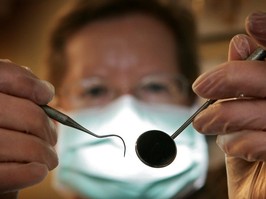by anne borden kingwhen michael’s daughter, sarah, was in preschool, a friend recommended a pediatric dental clinic that had made her family’s visits to the dentist easy.“the dentist told us it would be easier to put her under a general (anesthetic), which he said he used all the time,” he recalled. “well of course, that would be easier. my question was: ‘easier for who?’”michael and his wife got a second opinion from another dentist, who filled cavities and cleaned sarah’s teeth without a general anesthetic – and without meltdowns. i asked michael what the second dentist brought to the experience that was different from the first.“patience,” he said.their new dentist had been trained in
trauma-informed care – a practice that can be helpful to children, patients with sensitivities or anyone who’s experienced trauma. trauma-informed care itself extends into many settings, including schools, social work, prisons and medical settings. some health-care providers practicing trauma-informed care may also utilize a related concept:
dignity in care. at the core of dignity in care is the patient dignity question: “what do i need to know about you as a person to give you the best care possible?”noah belman, a toronto-based dentist who practices trauma-informed care, notes that dental care has a checkered past when it comes to considering patients’ emotional state.to many, anesthetizing children for simple procedures is a shortcut that doesn’t help them in the long run.“historically, dentists were tooth-focused, not necessarily patient-focused,” he told me. “it was ‘get the work done by whatever means,’ regardless of the effect on the psyche. the focus has shifted in many, but not all, settings.”the get-it-done approach can have long-term consequences, such as when a patient develops a phobia about going to the dentist (odontophobia). as the old adage goes, “ignore your teeth and they’ll go away.” patients who avoid the dentist may face a host of
problems including untreated tooth decay, gum disease and infection. those with chronic diseases such as heart disease and
diabetes may be at greater risk of dental emergencies that require urgent care.in addition to emotional trauma from past dental visits, other trauma in a patient’s life, such as being a survivor of childhood abuse, can inform a patient’s ability to cope during a routine dental procedure. writing for the british dental association, dental hygienist linda douglas
outlines principles of sensitive practice, including “respect, taking time, rapport, sharing information, sharing control, respecting mutual boundaries, fostering mutual learning.”douglas observed that people who survived abuse or other trauma may not acknowledge it to clinicians, yet it may be evident in their responses to various treatments. universally applying trauma-informed care to all patients is one way to ensure that the needs of those patients with trauma is covered.use of trauma-informed care is not universal to dental training or professional requirements in most jurisdictions. according to a spokesperson for royal college of dental surgeons of ontario, the professional association “does not have specific guidance on ‘trauma-informed care.’” the college referred me to the university of toronto school of dentistry, which does not explicitly offer teaching in trauma-informed care. a representative from the school sent me a statement that one of its courses “has a focus on communicative behavioural guidance techniques to build coping skills in the dental environment. what is referred to as ‘trauma-informed dental care’ is therefore indirectly addressed in this didactic course.” they added that in the school’s onsite clinic, “we innately educate the need for sensitivity toward existing patient fear and anxiety in our pediatric population and in other special patient groups.”belman, who credits the advice of a mentor for his approach, opts for flexibility when patients are fearful or hesitant. “i can fix broken-down teeth in time; i cannot fix a damaged psyche.” he points out that the mouth is an area of the body that’s used for breathing, eating and communicating. “control of the mouth is necessary for survival and giving up that control requires a great deal of trust.”belman says that some adults who show signs of neglecting their dental care may have been avoiding the dentist because of traumatic experiences in early life. indeed, some of the older methods of “calming” children are shocking today. one common method included putting a hand over a child’s mouth and/or nose to cut off their air flow, frightening them into compliance. known as the “hand-over-mouth exercise” or
home, this act was taught in many dental schools and only
eliminated from the clinical guidelines of the american academy of pediatric dentistry (aapd) in 2006. another method, the papoose board, is a form of restraint where children are immobilized by being strapped to a board. according to
marketing material of one company: “a struggling, frantic child can be completely immobilized in less than 60 seconds.”the american academy of pediatric dentists now recommends the “
least restrictive” methods for restraint,
noting there is “potential to produce serious consequences, such as physical or psychological harm” from methods like the papoose board. the royal college of dental surgeons of ontario “does not have any specific statement on the use of papoose boards.” the u of t dental school no longer uses the technique at its clinics, although “it is still listed as a method of ‘behaviour management’ which can be used only with expressed written consent (by the parent).”occupational therapists nicola mcmullen and greg santucci, both of whom work with disabled children, gave a resounding “no” to the concept of the papoose board.“it’s a form of restraint that would obviously cause anyone some level of trauma,” mcmullen told me. she advises dentists to ask new patients, especially those who are disabled, whether they have had any negative experiences or issues they want to discuss prior to their visit. for those returning to dental care following earlier trauma, mcmullen suggests an initial consultation, where the hygienist and dentist just talk with the patient, to build trust and comfort.santucci agrees, noting that giving children information in a relaxed setting can allow them to build a healthy relationship with dental visits.“in general, knowledge is power,” he told me. “visit the dentist just to say hi and sit in the chair. allow kids to explore the sensory environment before (the dentist) goes into their mouths.” santucci, who faces challenges with dental appointments himself, says that taking breaks is also a great strategy. “i have had a few procedures where i just wanted to catch my breath and get somebody out of my mouth for a minute. monitoring stress responses is important.”both mcmullen and michael are taking a long-term approach, hoping to establish the building blocks of trust between their kids and the dentist. mcmullen told me that while general anesthetic was first recommended for her daughter’s teeth cleaning, “we declined and asked for a longer appointment time. this made all the difference, and she had her procedure with just a local anesthetic.”michael is also glad he took his daughter to a dentist that practices trauma-informed care. “we hope she can feel good about going to the dentist (now), so that when she gets older she’ll keep on going to the dentist.”
anne borden king is the founder of the campaign against phony autism cures, canada and the host of noncompliant, a podcast about neurodiversity. her writing has appeared in the new york times and the globe and mail, among other publications. she is the winner of the 2021 helen henderson literary award from the centre for independent living toronto.this article is republished from healthy debate under a creative commons license. read the original article.
 6 minute read
6 minute read









